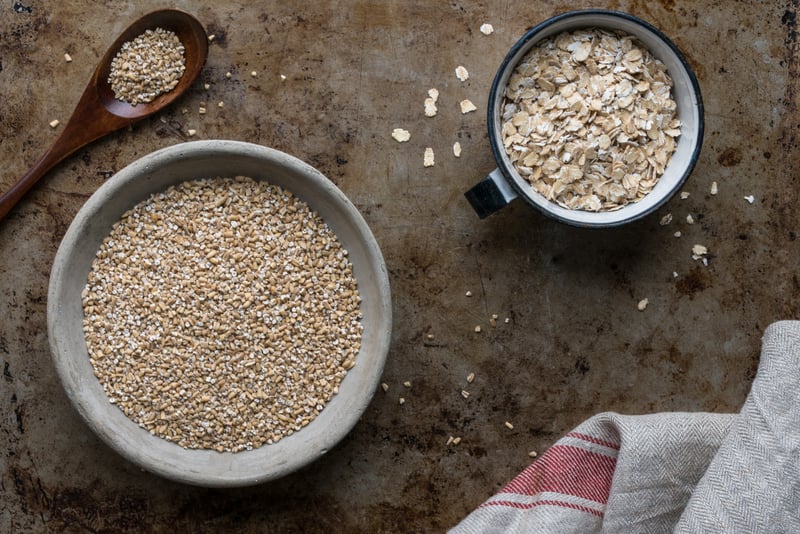Rolled vs. Steel-Cut Oats: Which Is Better for You?

If you’re looking for a versatile, heart-healthy, fiber-rich, and filling whole grain, oats check every box. They can form the basis of not just your morning oatmeal or overnight oats but can be used for granola bars, muffins, smoothies, cookies, and even meat dishes (e.g., meatloaf and meatballs). When standing in the oatmeal aisle, you may have noticed there are a lot of varieties in the lineup. Of course, skipping past the envelopes of sugar-loaded quick oats is a no-brainer. But when it comes to rolled vs. steel-cut oats, which are better for you?
Rolled vs. Steel-Cut Oats: What’s the Difference?
While they admittedly look very different, both rolled and steel-cut oats (sometimes called Irish oats, pinhead oats, or coarse oatmeal) come from the same whole grain. In their whole form, they’re known as groats from the Avena sativa plant. Once they’re separated from the outer hull, they become the oats we’re more familiar with. They still remain whole grains, though, as they provide the intact bran, germ, and endosperm, which contains the fiber and protein that provide so many of the benefits of oats.
The basic difference between rolled vs. steel-cut oats is in the processing. Rolled oats are steamrolled during the first stage of processing to help prevent them from cracking or breaking. They’re then rolled in mills until they’re softer and flat, giving them their well-known oval appearance.
Rolled oats can then be further processed, such as pre-cooked for “instant” oat varieties or rolled into thinner oats, so they cook faster. Traditional old-fashioned oats have a creamy, easy-to-chew texture that makes them easy to include in a variety of recipes.
Steel-cut oats, on the other hand, have minimal processing. They start with the same groats but are chopped into two to three smaller pieces (with a steel blade—hence the name) rather than flattened, leaving their pinhead or bead-like appearance. When prepared, they tend to have a thicker and chewier texture. They also take a lot longer to cook and aren’t as versatile. While they may not be right for an oatmeal cookie, they can still make a delicious and fiber-packed bowl of oatmeal.
Rolled Oats vs. Steel-Cut Oats Nutrition
Because of the different processing methods, there are a lot of differences in shape, size, cooking time, mouthfeel, and even digestion rate. Both versions of oats will provide long-lasting energy due to their fiber content. Steel-cut oats, though, take longer for digestive enzymes to break them down, which can help you stay even fuller for longer.
But what about their nutritional profiles? How different are they really? You may be surprised to learn that there’s very little difference in the amount of protein, carbs, fat, and even fiber in rolled vs. steel-cut oats. Here’s a comparison per 44-gram serving:
Rolled Oats Nutrition Facts
- Calories: 174
- Protein: 5.5 grams
- Fat: 2.7 grams
- Carbohydrate: 30 grams
- Fiber: 4.6 grams
SPECIAL OFFER: Ageless Turmeric Supports Healthy Inflammation Levels & Detoxification. Now Up to 71% Off.
Steel Cut Oats Nutrition Facts
- Calories: 160
- Protein: 5 grams
- Fat: 2 grams
- Carbohydrate: 31 grams
- Fiber: 4 grams
Both options are also great sources of micronutrients like manganese (for bone health), biotin (for healthy, glowing skin), and beta-glucan (an important fiber source that’s been shown to lower LDL cholesterol levels and support heart health). They’re also high in phosphorous, selenium, magnesium, thiamine, iron, zinc, and copper. They’re also both low in sugar with less than one gram per serving.
While oats are naturally gluten-free, for those who have celiac disease, look for oats that are certified gluten-free to avoid any contamination during processing.
No matter which type of oats you prefer, they may help promote heart health, stabilize blood sugar levels, improve digestive health, and provide long-lasting energy.
So, Which is Better?
Yes, steel-cut oats are slightly lower on the lower glycemic index (52 vs. 55), so they may impact blood sugar levels a bit less. Again, though, the differences are minimal. So, choose whichever variety you like the most—depending on your flavor, texture, recipe, and timing preference.
For example, if you want to make up some cold homemade granola or muesli, a traditional or unbaked oatmeal cookie, or oatmeal cakes, then rolled oats are a better option. But for a slow-cooker hearty, stick-to-your-ribs breakfast cereal, steel-cut oats are sturdier and hold up better.
Just take time into account as steel-cut oats take around 20 minutes to cook compared to just 2 to 5 minutes for rolled oats. Surprisingly, though, while most steel-cut oat recipes involve a slow-cooker, you don’t even always have to cook them. For example, steel-cut oats can be used in overnight oats and provide a more robust, chewy texture. (Personally, I use the quick-cook steel-cut oats from Trader Joe’s in overnight oats recipes as I enjoy the chewier texture.)
Even if you’re in a hurry, go ahead and walk past the instant packets that are loaded with added sugars, sodium, and other additives and choose whole oats instead. You can always add your own flavoring like fresh or frozen fruit, cinnamon or other spices, or include them in a variety of recipes. Oats don’t have to be sweet either. If you like a more savory breakfast, try topping them with black beans, sautéed peppers, and avocado or a perfectly cooked egg and salsa for a fun change of pace.
No matter which version you choose or how you add them to your diet, oats are an excellent, healthy food that fits into nearly every diet plan.



 7 Signs Your Body is Seriously Low on Collagen (not just wrinkles)
7 Signs Your Body is Seriously Low on Collagen (not just wrinkles) Health Expert: "Turmeric Doesn't Work (unless...)"
Health Expert: "Turmeric Doesn't Work (unless...)" 3 Warning Signs Your Probiotic Supplement is a Total Waste
3 Warning Signs Your Probiotic Supplement is a Total Waste

